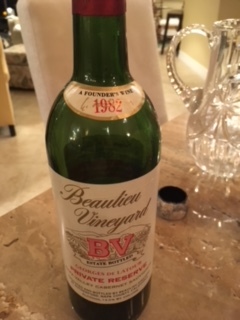Thanks to the generosity of new friends (hi, Ben!) I recently had a chance to re-taste the 1982 Beaulieu Vineyards Georges de Latour cabernet sauvignon. One sip of the legendary wine brought back a flood of fond memories.
I had started to collect wines in the late 1970s and the BV was simply priced out of my reach. Yet I swallowed hard, kept the receipt from my wife and snagged a couple of bottles. I cellared them for decades and visited the winery several times while I waited. As one of the four pioneering spirits that launched the Napa wine industry, I’ve always been enchanted with the people and place that made BV great.
The 1982 Georges de Latour was only one of BV’s two reserved cabernets made in that decade — BV made the Georges de Latour only in the best vintages. I held onto the wine for a remarkable 15 years and drank it with mutual BV admirers. Little did I know that the wine still had legs on it.
The reserve wine is named after the founder, Georges de Latour, who with his his wife bought 4 acres in Rutherford in 1900 and for decades struggled to make great wine like his French countrymen. They survived Prohibition by making sacramental wines and then brought in the famous Russian emigre Andre Tchelistcheff to improve the wines. Indeed, he did for several decades. Latour died, Tchelistcheff moved on (he came back to BV twice) and eventually the winery fell into the wrong hands: Heublein. BV, along with Inglenook which also was bought by Heublein, fell into a black abyss. Heublein eventually merged with Diageo, which sold BV to Treasury Estates in 2016.
I chronicle this history because it is common for wine quality to plummet with multiple owners, especially those that are publically owned and obligated to increase profits. What allowed the Georges de Latour private reserve to persevere, however, was the terrific vineyards it used and the winemakers who got the most from them. Joel Aiken, only one of four BV winemakers in its history, made the 1982. He restored BV’s tarnished image by improving quality and introducing new top-flight wines like Tapestry.
I’ve met Aiken a couple of times and there’s no question he put quality first. In fact, at 28 he became the youngest director of winemaking but always yearned to retreat to the hands-on experience of making wine and growing grapes. I always felt the 1982 was a turning point for BV.
How did the recent bottle taste? Wonderful. It may have lost its edge (who hasn’t after 37 years?), but the pedigree of these Napa vineyards and the winemaking team was still obvious in the bottle. Wonderful depth of character, balance and length. It had an old-Napa-world personality — not the bold, alcoholic fruit bombs I often taste today. Classic comes to mind.

